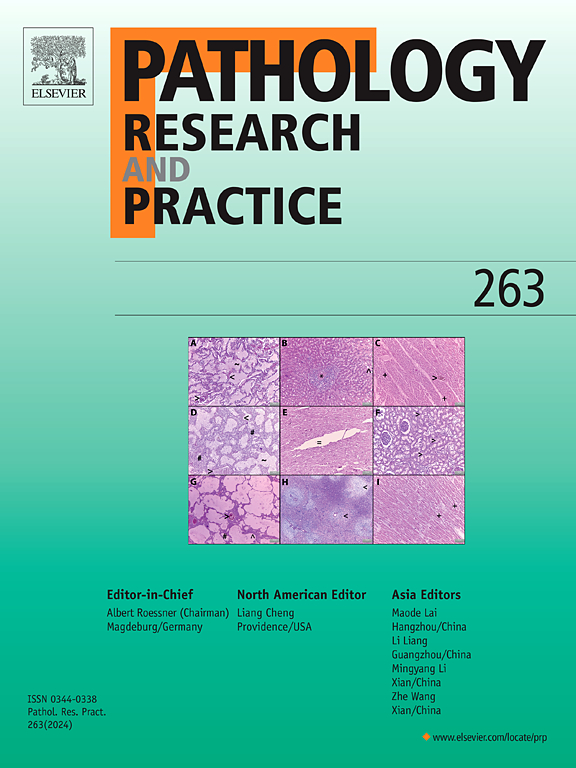Gastric-type extremely well-differentiated adenocarcinoma of the stomach: A rare tumor with diagnostic difficulties and high inter-observer variation in endoscopic pinch biopsies
IF 2.9
4区 医学
Q2 PATHOLOGY
引用次数: 0
Abstract
Extremely well-differentiated gastric-type adenocarcinoma (EWDGA) is a rare type of gastric cancer composed of deceptively bland-looking malignant cells resembling normal foveolar or pyloric epithelium. The histological features of this tumor have not been recognized by many pathologists, and inter-observer variation studies are lacking. Here, we report seven EWDGAs and inter-observer variation of six preoperative biopsies was evaluated by 11 pathologists in a single institute. Based on the pathological diagnosis of the endoscopic biopsy slides, the average rate of definite malignancy diagnosis was 15.2 %, and the overall diagnostic concordance rate was 34.9 % among 11 pathologists. Microscopically, the surface epithelium was preserved and only a few atypical tumor glands were scattered in most endoscopic biopsies. Structural atypia was minimal, and the tumor glands were barely distinguishable from normal glands. Although nuclear atypia was minimal, enlarged nuclei, relatively large glands with irregular shapes, and abundant cytoplasmic mucin were observed in gastric pinch biopsies. In preoperative biopsies, no cases showed p53 overexpression, and Ki-67 labeling index ranged from 3 % to 35 % and was higher compared to non-neoplastic glands in 3 cases. After gastrectomy, four (57.1 %) patients had advanced gastric cancer and three (42.9 %) had lymph node metastasis. Genomic profiling of the four patients revealed mutations of TP53, BRAF, KRAS, STK11, and MDM2/CCND1 amplification. Immunohistochemistry for p53 was not helpful while Ki-67 may be helpful when staining pattern is distinct from the non-neoplastic mucosa. In conclusion, it is challenging to diagnose EWDGA using biopsy specimens. Recognizing and addressing this rare entity will increase diagnostic accuracy to ensure the early diagnosis of cancer.
胃型极度分化腺癌:一种罕见的肿瘤,诊断困难,内镜夹取活检的观察者之间差异很大。
极度分化的胃型腺癌(EWDGA)是一种罕见的胃癌,由外观平淡无奇的恶性细胞组成,与正常的眼窝或幽门上皮相似。许多病理学家尚未认识到这种肿瘤的组织学特征,也缺乏观察者之间的差异研究。在此,我们报告了 7 例 EWDGA,并由一家研究所的 11 位病理学家对 6 例术前活检的观察者间差异进行了评估。根据内镜活检切片的病理诊断,明确的恶性肿瘤诊断率平均为 15.2%,11 位病理学家的总体诊断一致率为 34.9%。显微镜下,大多数内镜活检组织的表面上皮保存完好,仅散布有少量不典型肿瘤腺体。结构不典型性极低,肿瘤腺体与正常腺体几乎无法区分。虽然核不典型性极低,但在胃挤压活检中仍可观察到增大的细胞核、形状不规则的相对较大的腺体和丰富的细胞质粘蛋白。在术前活检中,没有病例显示 p53 过度表达,Ki-67 标记指数从 3% 到 35% 不等,3 例病例的 Ki-67 标记指数高于非肿瘤性腺体。胃切除术后,4 例(57.1%)患者为晚期胃癌,3 例(42.9%)为淋巴结转移。四名患者的基因组图谱显示,TP53、BRAF、KRAS、STK11 发生突变,MDM2/CCND1 扩增。免疫组化 p53 并无帮助,而当染色模式与非肿瘤性粘膜不同时,Ki-67 可能会有帮助。总之,使用活检标本诊断 EWDGA 具有挑战性。认识并解决这一罕见实体将提高诊断准确性,确保癌症的早期诊断。
本文章由计算机程序翻译,如有差异,请以英文原文为准。
求助全文
约1分钟内获得全文
求助全文
来源期刊
CiteScore
5.00
自引率
3.60%
发文量
405
审稿时长
24 days
期刊介绍:
Pathology, Research and Practice provides accessible coverage of the most recent developments across the entire field of pathology: Reviews focus on recent progress in pathology, while Comments look at interesting current problems and at hypotheses for future developments in pathology. Original Papers present novel findings on all aspects of general, anatomic and molecular pathology. Rapid Communications inform readers on preliminary findings that may be relevant for further studies and need to be communicated quickly. Teaching Cases look at new aspects or special diagnostic problems of diseases and at case reports relevant for the pathologist''s practice.

 求助内容:
求助内容: 应助结果提醒方式:
应助结果提醒方式:


